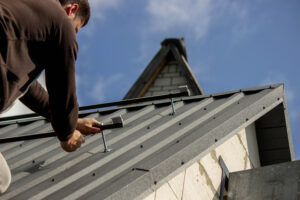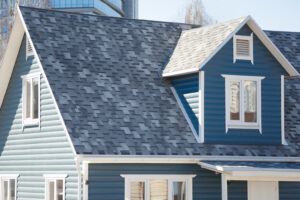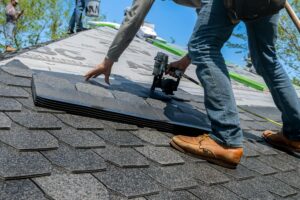Choosing the right shingle roofing is important to suit your home’s unique needs based on climate and your budget. Popular shingle types include 3-tab, architectural, wood, composite, metal, solar, slate, and clay. Each comes with a different price tag and its own advantages and disadvantages. Some offer better energy efficiency, while others are more costly upfront but are more durable. Affordable and versatile shingles are widely available in many colors and textures to complement any architectural style.
8 Different Types of Shingle Roofing
Are you thinking about installing a new roof but are unsure about the right shingle type for your home? With a wider range of shingle types available in the market, homeowners often feel confused when they look at the styles, colors, and textures available. Not every type suits your home’s needs, and doing thorough research is essential to make the right choice when deciding on residential shingle roofing. 214 Roofing in Arlington, TX, can make your roofing experience smooth and hassle-free, offering assistance through every phase.
|
Did you Know? Make sure that you know the weight limits of your home’s structure before choosing shingles. Some high-end heavy varieties require additional support and frames and can’t be installed without reinforcements. |
Here is your complete guide to 8 types of shingles and their pros and cons to make an informed roofing decision.
3-Tab Shingles
Also called strip shingles, they are the most basic type. These lightweight shingles have a long, thin look and lie flat on your roof. They are best for homeowners looking for budget-friendly options.
|
Pros |
Cons |
| Affordable
Easy to repair or replace |
Less durable Shorter lifespan of 15 to 30 years. |
Architectural Shingles
They offer a more dimensional and textured appearance as compared to the 3-tab and are a common choice for new constructions. These are ideal for homes facing harsh climates like heavy rains and hail.
|
Pros |
Cons |
| More durable
Longer lifespan |
Higher costs than 3-tab Susceptible to mold Susceptible to water damage. |
Metal Shingles
These are the eco-friendly roofing options, made from aluminum, steel, or copper, and are known for their durability. These are ideal for homes at risk of fires or harsh climates.
|
Pros |
Cons |
| Water Resistant
Fire Resistant Heat Resistant Durable Lightweight |
Higher costs Noisy during storms Difficult installation |
Composite Shingles
These can mimic the looks of traditional materials like wood or slate. They are made with a combination of fiberglass, mineral granules, and asphalt. They are ideal for homeowners looking for cost-effective solutions.
|
Pros |
Cons |
| Affordable
Easy installation Lightweight Require minimal maintenance |
Damage-prone Provide less energy efficiency. |
Solar Shingles
They can serve both as a roofing material and a power source and are becoming increasingly popular. These can add value to your home and are ideal for energy-conscious homeowners.
|
Pros |
Cons |
| Sleek integrated look
Eligible for the federal solar tax credit |
Expensive Upfront Complex specialized installation Not suitable for areas with less sunlight. |
Wood Shingles
These are an eco-friendly roof choice offering a rustic aesthetic. Wood shakes are ideal for homeowners who prefer environmentally friendly roofing options.
|
Pros |
Cons |
| Offers natural aesthetics
Resistant to UV rays and impact Lasts around 30 years |
Vulnerable to pests and rot High maintenance Complex installation Can’t be repaired |
Clay Shingles
Clay shingles are ideal for homeowners looking for an exceptionally durable roof that can withstand harsh climates.
|
Pros |
Cons |
| Excellent insulation
Can last up to 100 years Durable against fires and extreme weather |
Higher costs Complex installation Heavyweight, requires additional support |
Slate Shingles
Slate shingles are highly weather-resistant and are ideal for homes located in heavy snowfall regions.
| Pros | Cons |
| Extremely durable
Sustainable material Offers sleek, attractive looks Boosts curb appeal and property value |
Very expensive
Heavy weight Require additional support frames |
What are the costs of Different Shingle Types?
|
Shingles Type |
Cost Per Square Foot |
|
3-Tab Asphalt |
$3.5 to $7 |
|
Architectural Shingles |
$5 to $12.25 |
|
Metal Shingles |
$5 to $41 |
|
Composite Shingles |
$8.25 to $13.5 |
|
Solar shingles |
$22 to $26.5 |
|
Wood Shingles |
$5.75 to $14.5 |
|
Slate Shingles |
$12 to $30 |
| Clay Shingles |
$5.5 to $15.75 |
Conclusion
Not all shingle types are right for every home. Each has its own pros and cons and suits various climate needs. Whether you want a cost-effective option like basic 3-tab or composite shingles or are looking for a durable choice with a dimensional look like architectural shingles, there is a wide variety available to suit every home, budget, and climate. You must consider your specific needs before deciding on the right shingle type.
FAQs
1: What are category 4 shingles?
These are the shingles that offer your home maximum protection against hail damage. Category 4 resistance is the highest shingles can achieve.
2: Is it ok to paint my shingles?
Repairing shingles is ok if done correctly. It refreshes your roof’s look and offers solar reflectance, but it will require touch-ups every few years.
3: How much do eight bundles of shingles cover on my roof?
Shingles are available in bundles of 33 square feet of a roof’s surface. This means that you’ll be needing three bundles for every roofing square (100 sq ft).
4. What type of roof shingles lasts the longest?
Slate and clay shingles offer the longest lifespan, lasting 75–100 years with proper maintenance. They are durable against harsh weather, fire, and heavy snow, making them ideal for long-term investment.
5. Which roofing shingles are best for hot climates?
Clay, metal, and solar shingles perform best in hot regions. They reflect sunlight efficiently, reduce heat absorption, and help lower cooling costs throughout the year.


